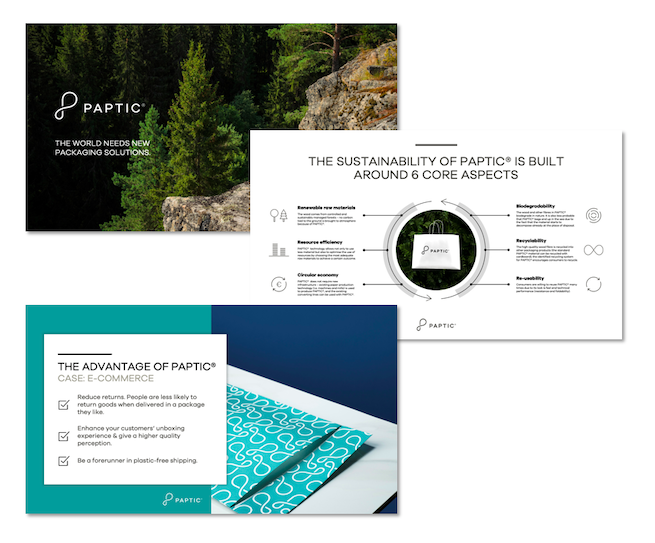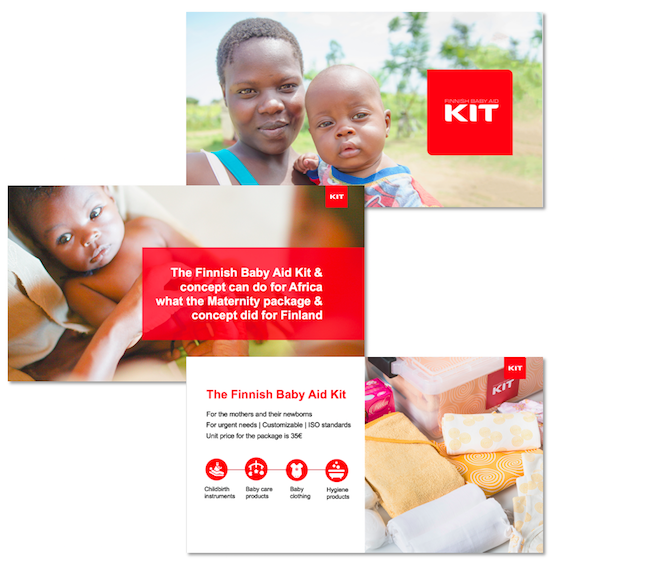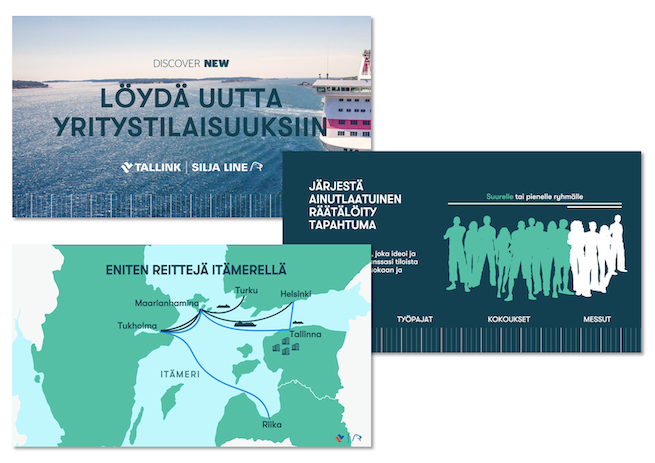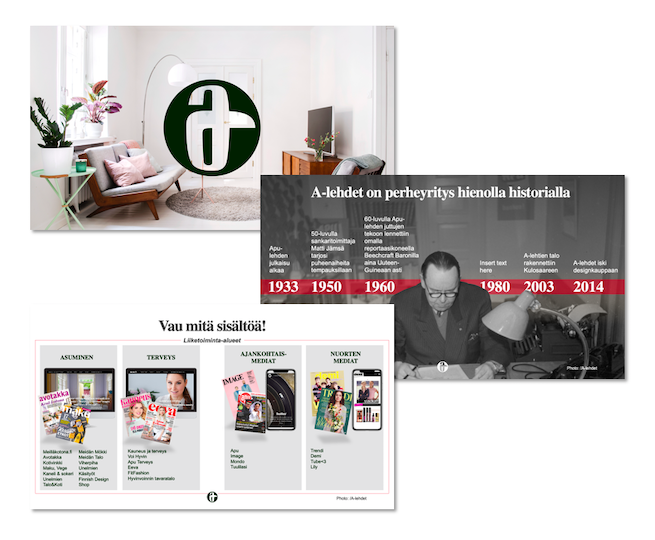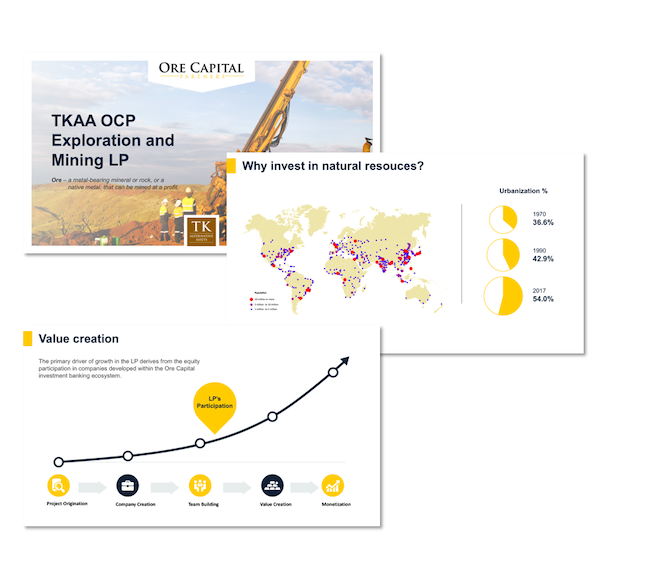The title says it all. Creating presentations is its very own area of expertise. It includes an understanding of the audience’s—most often the potential buyer’s—perspective, a capability to communicate effectively verbally and visually, as well as skilled use of the presentation tool, such as Powerpoint, to get the most out of it.
Here’s 5 examples of our work and 5 slightly leading questions to further open up the matter
This may come as a surprise, but presentation designers do not only work on presentation graphics. We also with the content. In fact, not a single finger should be lifted with the visuals before there’s clarity on the content. It’s like if you are invited to an event; would you decide what to wear without knowing the nature of the event? No, right?
The presentation design process starts from defining the main messages and crafting the story and structure. These should serve the company’s goal for the presentation and speak to the company’s potential clients. This is why we, at Havain, begin with a content workshop. The workshop is done together with our contact persons from our client company. It is a crucial first step in a successful presentation design project, after which there is a possibility to create visuals that actually support the message.
The importance of experience in creating impactful presentations
I have personally worked on over hundreds of presentations during the years. I’ve worked on the content and structure, as well as with the visual design together with our graphic designers. The presentations include company, internal, investor, speech, and most often, sales presentations. Especially speeches and sales presentations benefit from our expert perspective, as we always bring a new structure to them. Often with new structure, also comes new content.
Now, with this background information, let’s cut to the chase. I’ll show you five handpicked examples of our work and pose you five slightly leading questions.
Case: Paptic
We helped Paptic to define their main messages and create a sales presentation for them to use in their exciting global business. Paptic was admirably honest about wanting an outside-experts assistance in the process. Paptic wanted to get to the next level both in their sales communication as well as in their visual appearance. This project went truly like in the books, with serious dedication on content design before moving onto visual creation.
Question 1: What is it you want to say?
The greatest value of the presentation design process comes from transforming your presentations content and structure. Usually it means stripping away the unnecessary and adding pieces of content that you haven’t included yet, but your potential buyer’s appreciate. Only then can also the visuals work for your message.
This way also the content you already had before, may get noticed and be understood better. We challenge you, and scrutinise and tweak your current content. But we also help create you new effective content, so that you reach the next level in presenting.
Whether it’s words or visuals, you really need to work hard to only include what is relevant, necessary and supports the goal of the presentation. Including more than essentials defeats the purpose of a presentation. Why would you want to do that, since at it’s best a presentation helps the potential buyer make a decision about if they are interested enough to hear more?
Read more and evaluate “Is your presentation helping or hurting you?”
https://www.havain.fi/sales-presentation-aiding-hindering/
Case: Logonet Promotion
We helped Logonet Promotions tell the story about the Finnish Baby Aid Kit, or FBAK. FBAK is a concept and a maternity package, that can help African countries, just like a similar concept and package helped Finland. Already existing knowledge was crystallised into key messages which highlight the importance and potential of the Finnish Baby Aid Kit.
Question 2: What is it you want your audience to do?
Considering that all business-to-business-companies want to sell their products or services to other companies, it is astounding how few include any sort of call-to-action in their sales material. In fact, of the top of my head, I cannot think of many clients who have had a call-to-action in their sales presentation, that I’ve seen in the last year.
Do you have one? Could a call-to-action help at least some sales cases, if not a significant amount of them? Is there a benefit to helping your sales people by including in the material, i.e. in the standard pitch, a concrete next step that you propose to a potential buyer?
Read more about call-to-actions and other C’s in the below blog post.
Case: Tallink Silja
We helped Tallink Silja to create a new business-to-business sales presentation. Already in the beginning part of the presentation we make it clear, what we want the potential buyer to do. We also included a trigger in the end of the presentation, which should ensure, that when the time is right for the potential buyer, they are sure to contact Tallink Silja.
Question 3: How fluently could your client repeat your message?
Just how easy can you make it for someone else to repeat your message? Can you make it easy for your potential buyer to repeat it to their colleagues? You should, because the colleagues may have a say in the buying decision.
Something that is easy to repeat, can be said and heard often. And what is often heard, is the truth, right? If you don’t believe me, have a look at the following blog post where I discuss this.
Why using buzzwords in your presentation will bite you in the behind
Case: A-lehdet
We helped A-lehdet to renew their company presentation. A couple of things we absolutely loved about their existing messages, was the story about the family business which it still today is, as well as some easy to repeat messages right at the core of their business.
Question 4: Can you draw the next steps?
Martin luther King Jr. said that “you don’t have to see the whole staircase to take the first step.” The first step, is what you propose in your call-to-action. It is also beneficial, though, to show the whole staircase. The whole staircase shows what’s coming during the entire process, from the moment your buyer decides to buy, to the moment they can enjoy the delivery of your product or service.
What happens between now and then? It is a question in your buyer’s mind whether they ask it out loud or not. They do wonder, what steps there are in general, who does what—and especially what do they need to be able to do—and when can the process be ready.
Could you make the benefits you sell feel more attainable, when you visualise the process from start to finish? Have a look at the serious effect that visualisations can have, in the following blog post.
Process slides a tad more private, so instead of displaying some here, I’m happy to show you some selected examples in an online call. Book a time to talk with us.
Question 5: Could you be clear instead of comprehensive?
I am deliberately pinning these words against each other by displaying them as opposites. Presentations are presentations and documents are documents. Documents can be comprehensive, including all the smallest details and explanations for everything. Presentations, on the other hand, should be clear and concise.
Instead of displaying every piece of information you can offer, why not only display—or better yet, visualise—key concepts, that are enough to reach the goal of the presentation? Just like you, your presentation should work smarter, not harder. Unless you hate your potential buyer, don’t bore them to death with documents posing as presentations, but visualise where possible and necessary.
Below is a few tips for visualisations in Finnish.
Case: Ore Capital Partners & TK Alternative Assets
We helped Ore Capital Partners and TK Alternative Assets with an investor memorandum document. Investing is a delicate and detail heavy field, but in this document, where we could, we visualised to help the delivery of the information.
If you are thinking about gently updating or completely blowing up your old and creating a new presentation, do let us pitch our idea to help you! Book a time for an online call and tell us more about your case at hand.
Feature image by rawpixel on Unsplash.

